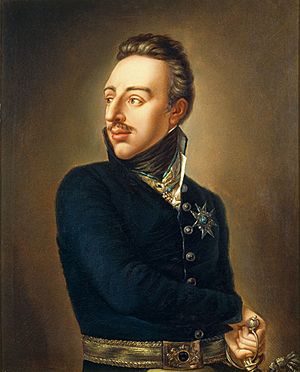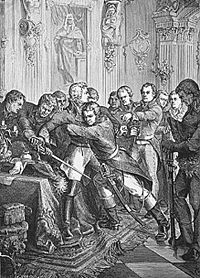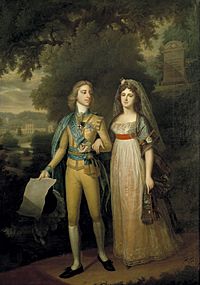Gustav IV Adolf facts for kids
Quick facts for kids Gustav IV Adolf |
|
|---|---|

Portrait by Per Krafft the Younger, 1809
|
|
| King of Sweden | |
| Reign | 29 March 1792 – 29 March 1809 |
| Coronation | 3 April 1800 |
| Predecessor | Gustav III |
| Successor | Charles XIII |
| Regent | Charles, Duke of Södermanland (1792–1796) |
| Born | 1 November 1778 Stockholm Palace, Sweden |
| Died | 7 February 1837 (aged 58) St. Gallen, Swiss Confederacy |
| Burial | 29 May 1884 Riddarholm Church |
| Spouse |
Frederica of Baden
(m. 1797; div. 1812) |
| Issue |
|
| House | Holstein-Gottorp |
| Father | Gustav III of Sweden |
| Mother | Sophia Magdalena of Denmark |
| Religion | Lutheran |
Gustav IV Adolf (born November 1, 1778 – died February 7, 1837) was the King of Sweden. He ruled from 1792 until he was removed from power in 1809. He was also the last Swedish king to rule Finland.
Russian forces took over Finland between 1808 and 1809. This event led to Gustav's removal by his own army officers. After he gave up his throne on March 29, 1809, a new set of rules for the government was quickly written. This document, called the Instrument of Government, greatly limited the king's powers.
The "Instrument" was approved on June 6, 1809. This date is now the National Day of Sweden. The new rules stayed in place until 1974. The crown then went to Gustav's uncle, Charles XIII. Charles had no children who could inherit the throne. This led to a search for a new successor. The next year, Jean-Baptiste Jules Bernadotte was chosen. He became the first king of Sweden's current royal family.
Contents
Early Life of King Gustav IV Adolf
Gustav Adolf was born in Stockholm, the capital of Sweden. His parents were Gustav III of Sweden and Queen Sophia Magdalena of Denmark. His mother, Sophia Magdalena, was the oldest daughter of Frederick V of Denmark.
Gustav Adolf had teachers like Hedvig Sofia von Rosen until he was four years old. After that, his father and Nils von Rosenstein taught him. When his father, King Gustav III, was killed in March 1792, Gustav Adolf became king. He was only 14 years old. His uncle, Charles, Duke of Södermanland, ruled for him as regent. This uncle later became King Charles XIII.
In August 1796, his uncle arranged for Gustav to visit Saint Petersburg, Russia. The plan was for Gustav to marry Grand Duchess Alexandra Pavlovna. She was the granddaughter of Catherine the Great. However, Gustav refused to let his future wife practice her Russian Orthodox faith freely. This stopped the marriage plans. When Gustav became an adult that year, many people thought he would be a simple, religious, and careful king.
Gustav Adolf's Political Views
Gustav Adolf quickly fired Gustaf Adolf Reuterholm, who was the duke-regent's main advisor. This made him even more popular. On October 31, 1797, Gustav married Friederike Dorothea. She was the granddaughter of Karl Friedrich.
This marriage seemed like it might cause a war with Russia. But King Gustav IV Adolf and Emperor Paul of Russia both strongly disliked the French republic. This shared dislike brought them together. Gustav was very afraid of the French Revolution's ideas. He was so worried about Europe's future that he delayed his own coronation for several years. He wanted to avoid calling a meeting of the parliament.
However, Sweden's money problems, left over from his father's war, were severe. There were also bad harvests in 1798 and 1799. These problems forced him to call the parliament to Norrköping in March 1800. When the king faced strong opposition from the parliament, he decided he would never call another one.
Losing Finland
Gustav Adolf's time as king was unlucky and ended suddenly. In 1805, he joined the Third Coalition against Napoleon. His military efforts did not go well, and the French took over Swedish Pomerania.
In 1807, his ally, Russia, made peace and an alliance with France. This left Sweden and Portugal as the only European allies of Great Britain. On February 21, 1808, Russia invaded Finland, which Sweden ruled. Russia said they wanted to force Sweden to join Napoleon's trade blockade, the Continental System. Denmark also declared war on Sweden.
Within a few months, almost all of Finland was lost to Russia. Because of this war, Sweden gave up the eastern part of its country to Russia. This happened on September 17, 1809, with the Treaty of Hamina. The new, self-governing Grand Duchy of Finland was then created within Imperial Russia.
Coup and Giving Up the Throne
Gustav Adolf's poor and unpredictable leadership in diplomacy and war led to his removal. A group of army officers planned to overthrow him.
On March 7, 1809, Lieutenant-Colonel Georg Adlersparre started a rebellion. He was the commander of a part of the western army. He marched his troops towards Stockholm. To stop the King from joining loyal troops, seven conspirators broke into the palace on March 13, 1809. They seized the king and imprisoned him and his family in Gripsholm castle.
The king's uncle, Duke Charles, was then convinced to lead a temporary government. This government was announced the same day. A parliament was quickly called and approved the revolution.
On March 29, Gustav IV Adolf gave up his throne. He hoped this would save the crown for his son. However, on May 10, the parliament, which was controlled by the army, declared that Gustav and his entire family had lost their right to the throne. This might have been because they feared Gustav's son would try to get revenge if he became king.
On June 5, Gustav's uncle was declared King Charles XIII. He accepted a new, more liberal constitution. This constitution was approved by the parliament the next day. In December, Gustav and his family were sent to Germany. He divorced his wife in 1812.
In exile, Gustav used several names, like Count Gottorp and Duke of Holstein-Eutin. He finally settled in St. Gallen, Switzerland. He lived in a small hotel, often alone and without much money, using the name Colonel Gustafsson. He died there after suffering a stroke. He was first buried in Moravia. Later, King Oscar II of Sweden suggested that Gustav's body be brought back to Sweden. He was finally buried in Riddarholm Church.
Royal Coat of Arms
|
|
Gustav Adolf's Family
In 1797, Gustav married Frederica Dorothea Wilhelmina of Baden. They had five children:
- Crown Prince Gustav (born November 9, 1799 – died 1877). After 1809, he was known as Gustaf Gustafsson, Prince of Vasa. He became an officer for the Habsburg family in Austria. He had a daughter named Carola, who married King Albert of Saxony. She did not have children.
- Princess Sofia Wilhelmina (born May 21, 1801 – died 1865). She married Grand Duke Leopold of Baden. Their granddaughter Victoria of Baden married King Gustaf V of Sweden from the Bernadotte family. This means that the current King Carl XVI Gustaf of Sweden is a descendant of Gustav IV Adolf.
- Prince Carl Gustaf, Grand Duke of Finland, Duke of Småland (born December 2, 1802 – died September 10, 1805).
- Princess Amalia (born February 22, 1805 – died August 31, 1853). She never married and had no children.
- Princess Cecilia (born June 22, 1807 – died 1844). She married Augustus, Grand Duke of Oldenburg, and they had children.
See also
 In Spanish: Gustavo IV Adolfo de Suecia para niños
In Spanish: Gustavo IV Adolfo de Suecia para niños





